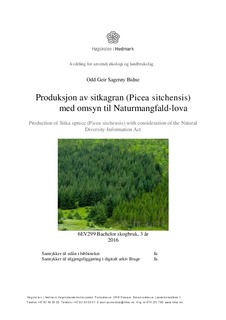Produksjon av sitkagran (Picea sitchensis) med omsyn til Naturmangfald-lova
Bachelor thesis

Åpne
Permanent lenke
http://hdl.handle.net/11250/2390987Utgivelsesdato
2016Metadata
Vis full innførselSamlinger
- Bachelor i skogbruk [32]
Sammendrag
Framande treslag av bartrær blei fyrst introdusert til Noreg på slutten av 1800
-
tallet, for å
produsere trevirke og utnytta vekstforholda på areala betre.
Eit av desse treslaga var sitkagran
(Picea sitchensis)
som opphaveleg kjem frå
Nord
-
Amerika der treslaget
veks på austkysten av
kontinentet. Sitkagrana blei etter kvart utplanta langs heile kysten av Vest
-
Noreg og treslaget
har vist seg og ha stor volumproduksjon på areala, samt å vere iherdig mot vind og sjøsprøyt.
I
seinare tid har treslaget uheldigvis vist seg å ha stor spreiingsevne, samt at plantefelta gjev
dårlige livsvilkår for lav,
mosar
og karplanter
og skapar ein ørken
nede på
skogbotnen.
Desse
negative verknadene
har
ført
til
at utplantinga av treslaget har møtt stor motstand
frå
miljø-organisasjonar. På den andre sida har nåtidas
klima-forandringar med stadig høgare CO2-innhald i lufta
ført
til
at sitkagrana med sin høge CO2-binding,
er blitt eit viktig treslag
å satse
på
for å redusera CO2-innhaldet i lufta.
Da ein skal ta omsyn og
ta vare på
natur-mangfaldet på areala der det planleggjas å setje ut
sitkagran, er
Naturmangfald-lova (2009)
og
Forskrift om utsetjing av utanlandske treslag
(2012), pliktige å følgje. Desse lovverka si rolle med omsyn til utsetjing av sitkagran, er at
treslaget ikkje skal skade eller redusera naturmangfaldet på areala i og rundt plantefelta,
gjennom heile livsomlaupet. I dag (2016), er det forplikta å sende søknad til fylkesmannen om
utplanting av sitkagran på det aktuelle arealet. Mange av desse søknadane blir godkjente av
fylkesmannen og vidare teken til
vurdering av miljø-organisasjonar. Dette har ført til at ein del
av dei godkjente søknadene er blitt forkasta på grunn av manglande registreringer av
naturverdiar rundt det aktuelle arealet og ein undervurdering av spreiingsevne og andre
uheldige påverknader på det biologiske mangfald.
Skal ein klare å produsere sitkagranskog med omsyn til Naturmangfald-lova har eg i denne
studien komet fram til at det ved kvar søknad om utsetjing av sitkagran i eit område, må
gjennomførast
ei skikkelig registrering av naturverdiane på areala i og rundt plantefelta av
fagfolk (biologer) før søknaden kan godkjennast. Denne registreringa må være fylkesmannen
sitt ansvar. Vidare må det bli pålagt å gjennomføre tiltak med å fjerne frø-spreidde sitkagran-planter i ein radius på opptil 5 kilometer, der internkontroll-system er inkludert. For å betre
forholda til lav,
mosar
og karplanter inne i plantefeltet, kan ein tynne opptil 40-50% av
ståande grunnflatesum utan at det går ut over produksjonsevna
til bestandet. Alien
coniferous
forest species
was first introduced to Norway in the late 1800s, to produce
wood and to better exploit the
growing conditions on site. One
of these tree species was Sitka
spruce (Picea sitchensis) which originated
from
North America where the tree-type grows
on
the east coast of the continent. Sitka spruce
was planted throughout the entire coastline of
Western-Norway, and the tree-species has later proven to have a large volume production in
this area, in addition
to being resilient to wind
-
and sea
-
spray. Unfortunately, the Sitka spruce
turned out to have a large capacity for spread, in addition to the fact that the areas with Sitka
spruce gives poor living conditions for lichen, mosses and vascular plants and creates
a “desert”
on the forest
-
floor
. These negative effects have
led to strong opposition from
environmental organizations
to the planting of timber. On the other hand, climate
-
change with
ever increasing
CO2 content in the air
has
led to Sitka spruce with
its
effective binding of
CO2,
to be
an important
species to preserve
, for reducing CO2 content in the air.
Since it is necessary to
take
preserve
biodiversity in areas
where Sitka spruce
is planned to be
planted
,
it is obliged to take the
Natural Diversity
-
Information Act (2009) and Regulations on
the launching of
foreign
tree species (2012), into account
.
This
legislation's
role with regard to
the launching of Sitka spruce is that the planting does not harm or reduce the natural diversity
of areas
in and around the planting fields throughout the entire
lifecycle.
Today (2016), it is
obligatory
to submit
an application to the county governor
for
planting of Sitka spruce in the
relevant area. Many of these applications are approved by the County
governor, while
more
advanced
applications is assessed by
environmental organizations.
This has led to
part of the
approved applications
being denied because of failure to record
natural values around the
particular area and an underestimation of the possibility of spread and other unfortunate
effects
on biological diversity.
To be able to
produce Sitka spruce forest in respect of
the
Natural Diversity
-
Act
I have in this
study figured out that in
each application for the release of Sitka spruce in a region,
it
must be
carried out a proper record of
the natural values of the areas
in and around the planting fields
by
professionals (
biologists)
before the application can be approved. This registration
must be
the county's responsibility. It must also be mandatory
to implement measures to eliminate
seed
-
spread of
Sitka spruce plants in a radius of up to 5 kilometers, where
the
internal control
system is included. To improve the conditions for lichen
, mosses and vascular plants within 4
the planting area,
it is possible to perform thinning of
up to 40-50% of
the stand area
without
compromising the production capability of
the stand.
Beskrivelse
Bachelor i skogbruk, Evenstad 2016